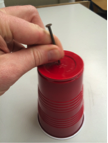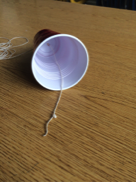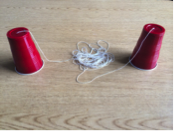Wave Fundamentals
RETIRED BETA VERSION - For current versions of the SciGen materials, please visit serpmedia.org/scigen
Sound Lab: Exploring the Nature of Waves
Making a VERY Old-School Telephone
Inset: Diagram of vocal cords, with a description of how they create sound waves and show those sound waves traveling to human ear, with a description of how the ear receives the sound waves. Sound waves are mechanical waves; they need a medium to transmit energy. When we clap our hands, the air between our hands gets compressed. The air molecules bump into each other, creating a vibration that travels through the air as a longitudinal or compression wave.
Materials:
- 2 cups
- 6 meters of string
- scissors
- nail (or other device for poking a small hole)
Preparation:
- Measure and cut a 6-meter length of string.
- Using the nail, poke one small hole in the bottom of each cup.

- Feed the string through the bottom of each cup and tie a large knot so that the string cannot pull out.


- After making a phone with a 6-meter length of string, you might try different lengths of string so students can see how the length affects the effectiveness of the phone.
Procedure:
- You and your partner each take a cup. Walk away from each other until the string is taut (tight from one cup to the other.)
- Take turns speaking softly into the cup while the other partner listens. Tip: put the cup over one ear and your hand over the other. You may hear the transmitted sound better and isolate it more clearly from sound in the room.
- Be sure to keep the string taut (tight) while you are using your old school phone. Have one partner speak into the cup, while the second partner listens. Touch the string at different points along it, and notice how this affects the sound. Move closer to each other to make the string loosen, and walk slightly farther apart to tighten the string. (But not so tight the knots fly out!) Record your observations for these different conditions in your lab notebook.
- Switch roles: the partner who spoke into the cup now listens to the other partner.
- Finally, both partners listen while one partner runs their finger along the string.
![]() Turn and Talk
Turn and Talk
Think about it. How does that work? Answer these questions in your lab book, or use this form.
When you speak into the cup, what type of wave are you creating?
What is the medium that is transmitting the sound wave from your mouth to the bottom of the cup?
What do you think happens when the sound waves reach the bottom of the cup?
How does the sound of your voice travel from your cup to your partner’s cup?
What happens when the sound waves reach your partner’s cup?
Describe the series of different materials that vibrated to make the telephone carry sound.
Which medium conducted sound more effectively- the air in the room or the cups and string? Why?
© SERP 2017
This Science Generation unit is currently in development. If you have comments or corrections, SERP would love to hear from you! Thank you.